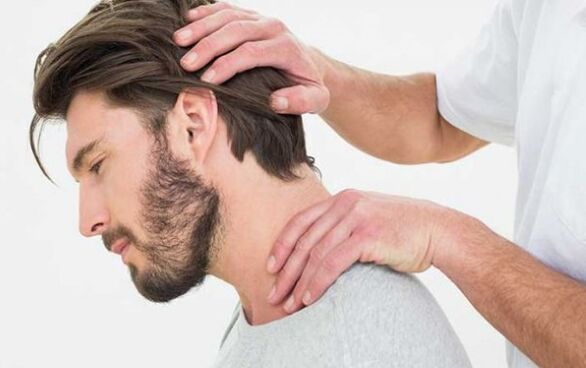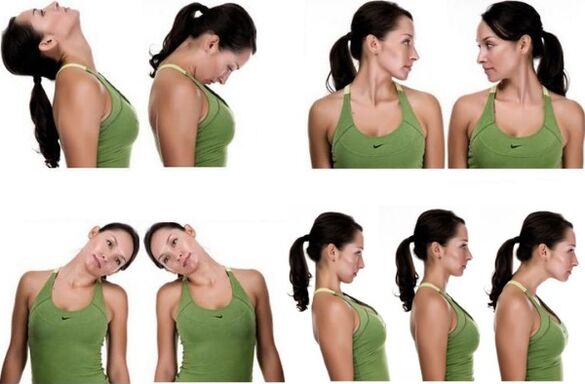Osteochondrosis of the neck is a pathology, the symptoms of which negatively affect a person's quality of life. Timely treatment of the disease will not lead to the destruction of the vertebrae and spinal stenosis.
What is osteochondrosis of the cervical spine
Cervical osteochondrosis is a metabolic disorder in the human axial skeleton. The painful process involves the vertebral discs (responsible for mobility), as well as the nervous and vascular systems.
Why is osteochondrosis of the neck dangerous?
The cervical vertebrae are the smallest of all 34 vertebrae of the human axial skeleton.They perform the most mobile function in the body - turning the neck with the head. There is a minimal change in the structure of the joint body, arch or processes of the vertebrae and displacement occurs, which leads to disruption of the neurovascular system and spinal stenosis.
Causes of the development of cervical osteochondrosis
Cervical osteochondrosis is a pathology of the spine, which has the following causes:
- physical inactivity;
- unbalanced diet;
- increased formation of uric acid salts;
- metabolic disorder;
- psycho-emotional stress;
- sedentary work (driver, computer typing operator);
- consequences of acute respiratory infections, ARVI;
- excess weight;
- damage to the axial skeleton;
- spinal hypothermia;
- endocrine disorders;
- load on the neck;
- distorted position of the body during night rest;
- autoimmune diseases.
Stages of development of osteochondrosis
The course of the pathological process in the cervical spine is accompanied by changes that must be divided into 4 stages:
- Phase no. 1.At the beginning of the development of osteochondrosis of the neck, the manifestations are mild. A person may not pay much attention to small painful changes that are going on in nature. At this stage, the elasticity of the cartilage is not lost, but the changes have just begun.
- Phase no. 2.This stage of the disease is characterized by damage to the cartilage tissue of the vertebrae. The process gradually moves to the body's joints, muscles and vascular system. The pain appears due to pressed nerves, to which the arms, shoulders and subscapular region (on the affected side) react. Which very often, at this stage of the disease, can be confused with other pathologies of the body.
- Phase no. 3.This stage of the pathological process is characterized by the destruction of the disc without rupture of the ring, which should be called protrusion.
- Phase no. 4.At this stage, it is inevitable to undergo an operation - the process goes too far: a disc is displaced, which compresses the spinal canal - a disc herniation. Manifestations in the form of a displacement of 2 mm are threatening to human life.
Symptoms
Cervical osteochondrosis (symptoms and treatment do not depend on gender) affects both men and women equally. The manifestations of the disease will correspond to the stage of the pathological process.
Phase no. 1 - this stage is not manifested by severe symptoms:
- neck pain;
- paresthesia on the side of the injury (numbness of the hand);
- fatigue;
- prostrate.
Phase no. 2 - the nature of the pathology becomes more visible to the patient:
- pain in the affected area of a painful nature;
- numbness (transition) in the cervical area;
- migraine (due to vasospasm);
- hypertension;
- decrease in physical activity;
- prostration;
- pain in the back, blade and arm (from the pathological process);
- chest pain.
Phase no. 3 is characterized by the manifestation of symptoms that must be treated very seriously:
- the appearance of protrusions (protrusion of the fibrous ring in the spinal canal);
- strong painful sensations radiating to the shoulder, arm;
- neck numbness.
Phase no. 4 differs from the third by a rupture of the ring with its inherent symptoms:
- the neck is bent;
- neck muscles lose the ability to hold the head;
- paresthesia of neck and head muscles;
- severe pain in the arms and neck region;
- numbness of the tongue;
- insomnia.
In the fourth stage, a neurologist recommends surgical intervention.
Syndromes caused by osteochondrosis of the cervical spine
The pathological course of osteochondrosis in the neck of the human axial skeleton should be divided into syndromes - based on a set of symptoms with characteristic signs.
Cervical complex:
- hearing is impaired;
- the vertebral artery undergoes pathological changes.
Radicular-vertebral syndrome:
- C2– pain in the back of the head, weakness of the mylohyoid muscles;
- C3- tongue hyperemia, slurred speech, incomplete jaw muscle paralysis, neck numbness;
- C4– pain and weakness of the clavicle muscles, breathing problems, pain of unknown etiology in the hepatobiliary system, numbness of the cervical-collar area;
- C5– the syndrome is manifested by numbness in the shoulder, weakness and decrease in the volume of the superficial muscle of the shoulder;
- C6 -the main manifestation of the pathology is pain from the neck to the shoulder, numbness of the thumb;
- C7- characterized by pain from the neck under the shoulder blade, numbness of the index and middle finger (on the side of the injury);
- C8– pain manifests from the neck to the elbow and little finger, paresthesia of the shoulder, shoulder blade and affected finger.
Reflex-irritation syndromes:
- Painful:cervicalgia (morning); pain in the neck and occipital region; pain in the neck, causing a nagging pain in the shoulder;
- muscle tonic:muscle tension; annoying pain in the back of the head; pain in the subscapular region; spasm of the cervical area; deformation of the shoulder joints; atrophy of shoulder muscles.
SPA:
- the consequence of mechanical damage is a narrowing of arterial vessels;
- organic damage of brain activity;
- migraine;
- turning pain in the back of the head;
- neurological pain of the skin on the head;
- hearing loss;
- gait instability;
- the feeling of the visibility of the waves of the sea;
- fainting states.
Compressive myelopathy:
- pain and numbness of the limbs;
- sensitivity disorders;
- minor disorders of the pelvic organs;
- facial numbness.
Craniovertebral anomaly:
- shocking;
- intracranial hypertension;
- psycho-emotional balance disorder;
- headache in the parietal and occipital areas;
- vomiting reflex;
- pallor of the optic nerve;
- dizziness;
- disturbance of oculomotor reflexes;
- asthenia;
- depressive state.
Diagnosing
Cervical osteochondrosis - symptoms depend on the course and form of the disease. To begin therapy for a pathological process, an accurate diagnosis must be made.
A neuropathologist and vertebrologist is involved in the diagnosis and treatment of spinal pathologies. To make an accurate diagnosis, you should contact the aforementioned doctors and during the examination and face-to-face interview, the specialist will conclude what examinations should be conducted.
If necessary, you should:
- computed tomography of the neck;
- magnetic resonance of the damaged area;
- SCT of ships;
- X-ray of the spine in several projections;
- visit to an ophthalmologist to measure intraocular pressure;
- Doppler ultrasound of blood vessels;
- ENMG of the hands;
- clinical blood test;
- Detailed analysis by ESR.
Based on all examinations, the neuropathologist makes a diagnosis and prescribes therapy.
Treatment of osteochondrosis of the cervical spine
Today, there are many methods and medications that help fight the pathology of the cervical spine.

In non-advanced stages, medications are used for systemic use:
- antispasmodics;
- pain relievers;
- NSAID - non-steroidal anti-inflammatory drugs;
- preparations containing collagen - for the restoration of cartilage tissue;
- vitamin therapy with group B drugs.
Local medicines:
- pain relief ointment;
- compresses that relieve inflammation;
- chondroprotectors;
- ointment with warming effect.
Physiotherapy procedures:
- therapeutic and recreational massage of the cervical area;
- reflexology;
- exercise therapy;
- the use of a special orthopedic neck brace.
Surgery:
- for sensitivity disorders;
- with great stenosis of the spinal canal.
First aid for severe pain
Treatment of symptoms of cervical osteochondrosis in the form of acute pain consists in following some first aid rules:
- compliance with strict bed rest;
- the use of antispasmodics and sedatives;
- fixing the neck with a special brace or collar;
- You should also wrap your neck with a warm scarf;
- for swelling, you should take a diuretic;
- external use of anesthetic ointments;
- use of muscle relaxants;
- the use of sedatives.
All listed drugs must be prescribed by a neurologist.
Drug treatment
Features of drug therapy include the use of anti-inflammatory, antispasmodic drugs, which will help relax muscles, the use of drugs to improve blood circulation, and also prescribe drugs that improve and restore the structure of cartilage tissue - chondroprotectors.
NSAIDs
Nonsteroidal anti-inflammatory drugs are the first aid in the treatment of osteochondrosis of the cervical spine.The use of this group of drugs will help relieve or completely relieve the pain. NSAIDs are drugs that act at the source of inflammation; the use of the drug can reduce the manifestations of the inflammatory process.
Non-steroidal drugs help improve blood circulation. NSAIDs should be used both for systemic treatment (tablets, injections) and for local therapy - ointments, gels.
Muscle relaxants
Medicines that reduce skeletal muscle tone are called muscle relaxants. Medicines of this group should be used for cervical osteochondrosis due to their effect on muscle stiffness, which occurs as a result of a pathological process in the spine.
The disease affects the nerve endings, which in turn are manifested in the form of pain and muscle spasms. This process is affected by muscle relaxant drugs, relaxing the affected muscles and removing the pain.
Hormonal drugs
The most powerful drugs with analgesic, anti-inflammatory and vasostimulating effects include hormonal drugs of the corticosteroid group. Medicines of this type have the ability to stop tissue destruction, reduce degenerative joint processes and improve microcirculation.
All medications belonging to the group of steroid hormones are prescribed only by a neurologist and under strict monitoring of the patient's condition (due to the large number of side reactions).
Paravertebral block
Special local anesthesia using injections is called paravertebral block. A neuropathologist or anesthesiologist injects a special medicinal mixture into the affected area of the spine, more precisely into the painful places near the affected part of the spine - at the exit of the nerve endings.
Using this method, severe pain is quickly relieved, hyperemia disappears and local metabolism improves.
ointment
In the treatment of osteochondrosis of the cervical spine, not only systemic drugs in the form of tablets and injections, but also local agents should be used.Ointments are widely used for pathological processes in the spine.
For treatment, chondroprotectors, NSAIDs, herbal painkillers and ointments with a warming effect should be used.
Chondroprotectors
Systemic drugs that restore cartilage tissue are called chondroprotectors. Taking drugs stimulates the regeneration of the cartilage apparatus in the joints.
Homeopathic remedies
One type of treatment for cervical osteochondrosis is alternative medicine or homeopathy. The use of this type of medicine has given good results.
Medicines for the treatment of dizziness in osteochondrosis
When treating dizziness that occurs against the background of degenerative changes in the spine, it is necessary to use several types of drugs. Each has its own action.
- Nootropics– improves microcirculation, calms the nervous system, improves the relationship between the hemispheres of the brain.
- Drugs for the treatment of vestibular disorders.They show their activity in expanding the blood vessels of the brain, thus improving blood circulation.
- Venotonics- these are products that improve the tone of the vascular system and blood circulation.
Vitamins and minerals
Preparations based on vitamins and minerals help to restore cartilage tissue faster, improve muscle nutrition and blood circulation.
Shantz's neck
Symptoms of cervical osteochondrosis during a pathological process in the spine can be acute. In this case, the Shants cervical collar should be used.

The bracket or holder is shaped like a circle.Made of dense foam rubber, which is attached to the neck with Velcro. No special skills are required to use a medical fixative. You need to put your chin on the collar and tie it at the back.
The fixator relaxes the muscles in the cervical spine, relieves pain and tension. It is an integral part of first aid for worsening neck osteochondrosis.
Needle applicator
One of the methods for treating degenerative neck pathologies is the use of a needle applicator - a massager in which there are spikes. The plate has a flexible structure and can take different forms.For use in neck pathologies, the applicator has clips.

There are many nerve endings in the skin that are touched by the applicator when it is used. This treatment helps restore metabolic processes in the intervertebral discs, removes hyperemia and inflammation and improves microcirculation. The use of a needle applicator has a positive effect on the treatment of osteochondrosis of the neck.
Physiotherapy
Physiotherapy treatment should be used to treat inflammatory and degenerative changes in the neck.Using the method helps improve metabolic processes and reduce pain.
The physiotherapeutic method of treatment has an anti-inflammatory effect and also promotes tissue regeneration. For osteochondrosis of the cervical spine, it is necessary to use ultrasound wave treatment, magnetic therapy and treatment with small amounts of current (electrophoresis).
Manual therapy
Manual therapy is a massage in which the hands of a manual therapist do not work with soft tissues, but with joints and ligaments. During the manual massage sessions, a specialist helps to restore the mobility of the spine and the pain goes away.

Normal blood circulation is restored, swelling disappears.
Therapy should be performed by a specialist who regularly practices this treatment method. To achieve positive results in the form of pain reduction, sometimes a few sessions are enough.
Acupuncture
Acupuncture refers to non-traditional methods of treatment.But the use of special needles, which are screwed into the body by a reflexologist, affecting certain nerve endings and areas, leads to positive results. Acupuncture improves metabolic processes, relieves local swelling and improves blood circulation.
Exercise therapy for cervical osteochondrosis
The type of physical therapy for osteochondrosis of the neck differs from other types of exercise. The cervical vertebrae are the smallest, and even their minimal displacement in the spinal canal is fraught with compression of the arteries supplying the brain, as well as compression of the spinal cord. Therefore, you should know that there should be no sudden movements during physiotherapy exercises.
Exercises for the cervical spine (those suffering from vertigo should use a sitting position):
- Basic position– standing with a straight back, facing forward. It is necessary to carefully turn the head to the right (without bending it back or forward) at the level of the shoulders and adjust the body. After a few seconds, return to your previous position. The same should be done on the other side. There should be no pain.
- Initial position– back straight, face looking forward. You should lie down gently, bending your head, with your right ear on your shoulder. You should imagine that your left ear is reaching up and try to do this. Hold yourself in this position for a few seconds. Return to the starting position. Do the exercise on the other side.
- Standing straight, you should look down at your feet and lower your torso down– bead by bead – towards the floor. For the untrained, you need to grab your knees, straighten your back parallel to the floor, with your face looking forward. This exercise works the entire spine, especially the neck. Stay longer. Relax with your head and torso down. Slowly, without haste, in order not to provoke dizziness, return to the starting position, vertebra by vertebra.
- Stand up straight, or you can sit in a chair with a straight back.Without bending your back, you should lower your chin to your chest and stretch the back of your head up - as if stretching your vertebrae. Hold the position for a few seconds and slowly, relaxing, straighten your neck.
- Rotational movement of the neck and head.A straight back, you can sit in a chair. Lower your head with your right ear on your shoulder and slowly, slowly, from this position, make a semicircle through your chest, to the opposite (left) shoulder and back. Straighten up.

Gymnastics should be done every day. You can not do physical therapy on an empty stomach - this can cause dizziness. You should exercise one hour after eating.
Treatment with folk remedies
The use of traditional methods for cervical osteochondrosis does not always lead to the desired result - you cannot heat the neck (only dry heat). Therefore, there are not many effective methods, but they exist.
Folk remedies:
- Tea made from a healthy herb (yarrow).You need to take some dry medicine, pour it into a cup and pour boiling water over it. Dilute it as a tea and drink it after meals. It relieves inflammation well and calms the nervous system.
- Medicinal drink made from burdock.Take a small amount of dry grass, pour it into a 500 ml thermos and pour boiling water over it. Persist. The resulting volume of medicinal drink should be drunk one day without leaving it for the next day. You should drink between meals. It has an analgesic effect.
- Compress made from plants.You should take the same amount of chamomile, salvia, tussilago - the herbs should be dried and ground. Pour boiling water over it. Persist. Wet a cotton cloth with the resulting solution and apply it to the sore spot on the neck. Cover with film and wrap with a scarf. Leave it overnight. Helps relieve inflammation.
- Apple cider vinegar.This is a very healthy, natural juice that is obtained by a microbiological process from apples. It contains a large amount of useful substances. You need to dilute the same amount of vinegar with water. Wet gauze with the resulting liquid and apply it to the back of the cervix, covering it with polyethylene and a scarf at night. It helps restore cartilage tissue and relieve inflammation.
For general strengthening and filling the body with useful substances, you should drink medicine with apples. It is necessary to add 10 g to water and drink before meals.
Therapeutic massage and self-massage
Massage for diseases of the cervical spine should be done only when there is no active inflammatory process - this is an additional effective method of treating osteochondrosis. Massage can be therapeutic, which should be done by a specialist massage therapist, or self-massage, when the patient knows which exercises will not harm him, but will help him.
During the therapeutic massage, the hands of a masseur are used, who work with the cervical area with soft, massaging, caressing movements.Neurologists call neck massage "erotic" massage, due to the very gentle specificity of the movements.
Strong and safe techniques should not be allowed - this can damage the vertebrae and blood vessels. If necessary, if the upper limbs are involved in the pathological process, then you should rub your hands. The movements should be directed from the fingertips up - to the shoulder and neck. Each side takes turns.
Self-massage includes light movements, stroking and light rubbing of the neck area.
You can not twist the neck or try to crack it - such techniques can lead to displacement of vertebrae and constriction of arteries and veins. The purpose of self-massage and therapeutic massage is to maximize the relaxation of spasmodic tissues and improve blood circulation.
Surgery
Surgical intervention is prescribed only if conservative therapy has not led to positive results and the process of vertebral destruction continues to progress.
The most used method of surgical therapy is the anterior approach method (the operation is performed in the front of the neck). Neurosurgeons rarely use the posterior method of surgical intervention - only when it is necessary to increase the lumen of the narrowed spinal canal.
Nutritional properties
The basic principles of nutrition for osteochondrosis include a balanced diet with a restriction of harmful foods for this disease.You should eat five times a day, in small portions.
The diet should include low-fat protein foods, unrefined cereals, vegetables (non-acidic), fruits, lactic acid products, preferably not produced from cow's milk. The intervals between meals should be no more than 3 hours.
All types of canned foods, alcohol, spices, refined fats and pork should be excluded. Semi-finished products bought in the store, as well as all sausages - such food disrupts metabolic processes and contributes to inflammatory and degenerative changes in the musculo-articular system.
What is not recommended to do
Cervical osteochondrosis is a disease that, with a wrong lifestyle, can progress a lot. There are certain rules, the implementation of which will reduce the likelihood of a further destructive process in the neck.
It's banned:
- consume large amounts of salt and salty foods;
- do weightlifting and gymnastics;
- for the right half, you should avoid tight shoes with high heels;
- refrain from excessive food, which will certainly lead to weight gain and disruption of metabolic processes;
- Sleeping on a soft bed is unacceptable;
- provoke a jerk with sudden movements of the neck, even if it seems to bring relief.
Preventing
To prevent the development of cervical osteochondrosis, you should adhere to preventive measures:
- visit the steam room (with the permission of a neurologist or if there is no hypertension);
- do periodic therapeutic massage;
- if the disease already exists and has been treated, undergo treatment courses with the recommendation of a neurologist;
- Go swimming;
- yoga gymnastics is the main type of therapeutic and preventive physical activity;
- Balanced diet;
- giving up bad habits - alcohol and nicotine, which disrupt metabolic processes in the body.
The appearance of cervical osteochondrosis is easier to prevent than to treat. At the first symptoms of the disease, you should consult a neurologist to prescribe adequate treatment. This will prevent the pathology from destroying the cervical vertebrae.



















